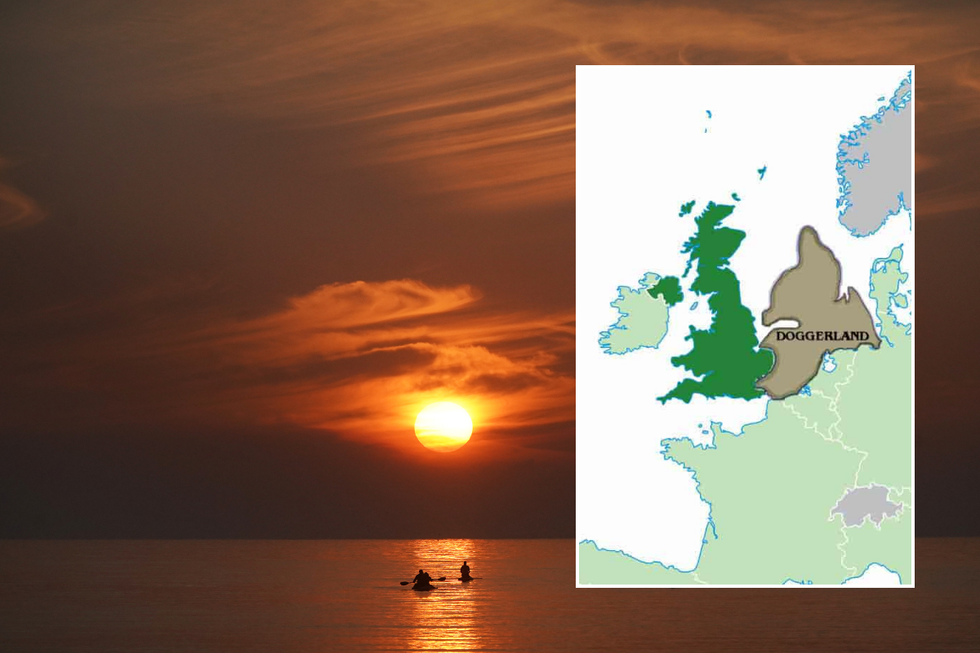Archaeologists have begun dredging the North Sea floor less than 20 miles off Norfolk's coast, uncovering Stone Age artefacts that date back more than 10,000 years.
The discoveries, including cutting tools and flint flakes, are part of an extensive investigation into an ancient landscape.
The area was once dry land before flooding when sea levels rose 7,000 years ago.
Whilst it was previously thought the floods had erased all traces of Stone Age life, these new findings suggest otherwise, offering fresh insights into Britain's prehistoric past.

In 8000 BC, the southern North Sea contained around 80,000 square miles of dry land, an area that would become known as Doggerland.
By 6500 BC, only 5,000 square miles remained, with an average loss of 50 square miles annually to rising seas.
The flooding was catastrophic for Stone Age inhabitants. Professor Gaffney told the Guardian in 2020: "If you were standing on the shoreline on that day, 8,200 years ago, there is no doubt it would have been a bad day for you."
The disaster claimed thousands of lives as a series of small tsunamis eventually submerged the entire region.
LATEST DEVELOPMENTS
- Woman wins 'petty' revenge on work colleagues after her lunch stolen from office fridge
- Azerbaijan Airlines flight 'shot down by Russia' after being mistaken for drone
- Scientists warn volcanic eruption could be disastrous for humanity
WATCH: Oil expert gives verdict on Labour’s North Sea Oil plan
The University of Bradford is leading the archaeological investigation in partnership with Belgium's Flemish Marine Institute and the North Sea wind farms community.
Professor Vince Gaffney, who leads the project, said: "Our investigations at the bottom of the North Sea have the potential to transform our understanding of Stone Age culture in and around what is now Britain and the near continent."
The Stone Age inhabitants of Doggerland primarily sustained themselves by hunting red deer and wild boar, whilst also harvesting shellfish.
The research is being conducted in collaboration with Historic England's Marine Planning Department as part of Britain's efforts to reach net zero.
The seabed holds particular archaeological significance as it has remained largely untouched since flooding occurred between 10,000 and 7,500 years ago. Unlike on land, where subsequent human activity has destroyed much early evidence, the North Sea floor has preserved Stone Age hunter-gatherer landscapes almost intact.
This preservation is remarkable, considering that 99 per cent of Britain's human occupation period predates Neolithic settlement, most of which has been obliterated by more recent human activity.
Professor Gaffney emphasised the modern relevance of these underwater discoveries, stating: "As we delve into the past, we are beginning to appreciate ever more clearly what future sea-level rise could do to humanity."
Experts said the dramatic submersion of Doggerland serves as a stark warning for coastal communities worldwide facing climate change threats.
from GB News https://ift.tt/vmJAV9r
Archaeologists have begun dredging the North Sea floor less than 20 miles off Norfolk's coast, uncovering Stone Age artefacts that date back more than 10,000 years.
The discoveries, including cutting tools and flint flakes, are part of an extensive investigation into an ancient landscape.
The area was once dry land before flooding when sea levels rose 7,000 years ago.
Whilst it was previously thought the floods had erased all traces of Stone Age life, these new findings suggest otherwise, offering fresh insights into Britain's prehistoric past.

In 8000 BC, the southern North Sea contained around 80,000 square miles of dry land, an area that would become known as Doggerland.
By 6500 BC, only 5,000 square miles remained, with an average loss of 50 square miles annually to rising seas.
The flooding was catastrophic for Stone Age inhabitants. Professor Gaffney told the Guardian in 2020: "If you were standing on the shoreline on that day, 8,200 years ago, there is no doubt it would have been a bad day for you."
The disaster claimed thousands of lives as a series of small tsunamis eventually submerged the entire region.
LATEST DEVELOPMENTS
- Woman wins 'petty' revenge on work colleagues after her lunch stolen from office fridge
- Azerbaijan Airlines flight 'shot down by Russia' after being mistaken for drone
- Scientists warn volcanic eruption could be disastrous for humanity
WATCH: Oil expert gives verdict on Labour’s North Sea Oil plan
The University of Bradford is leading the archaeological investigation in partnership with Belgium's Flemish Marine Institute and the North Sea wind farms community.
Professor Vince Gaffney, who leads the project, said: "Our investigations at the bottom of the North Sea have the potential to transform our understanding of Stone Age culture in and around what is now Britain and the near continent."
The Stone Age inhabitants of Doggerland primarily sustained themselves by hunting red deer and wild boar, whilst also harvesting shellfish.
The research is being conducted in collaboration with Historic England's Marine Planning Department as part of Britain's efforts to reach net zero.
The seabed holds particular archaeological significance as it has remained largely untouched since flooding occurred between 10,000 and 7,500 years ago. Unlike on land, where subsequent human activity has destroyed much early evidence, the North Sea floor has preserved Stone Age hunter-gatherer landscapes almost intact.
This preservation is remarkable, considering that 99 per cent of Britain's human occupation period predates Neolithic settlement, most of which has been obliterated by more recent human activity.
Professor Gaffney emphasised the modern relevance of these underwater discoveries, stating: "As we delve into the past, we are beginning to appreciate ever more clearly what future sea-level rise could do to humanity."
Experts said the dramatic submersion of Doggerland serves as a stark warning for coastal communities worldwide facing climate change threats.



0 Comments
Don't share any link